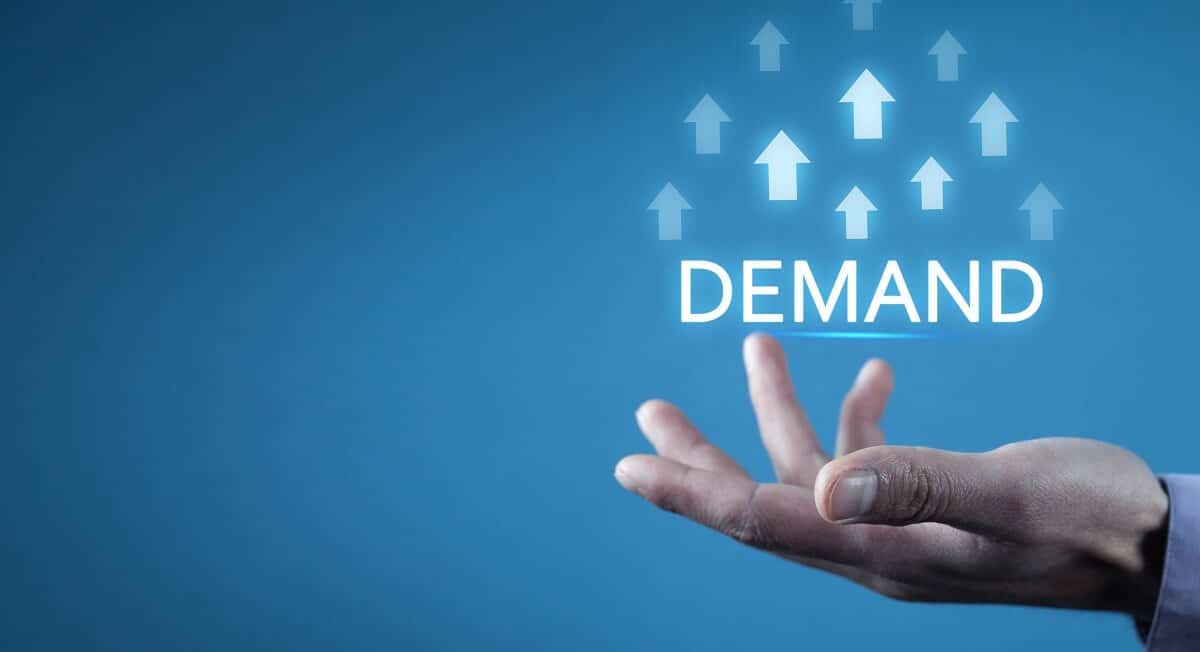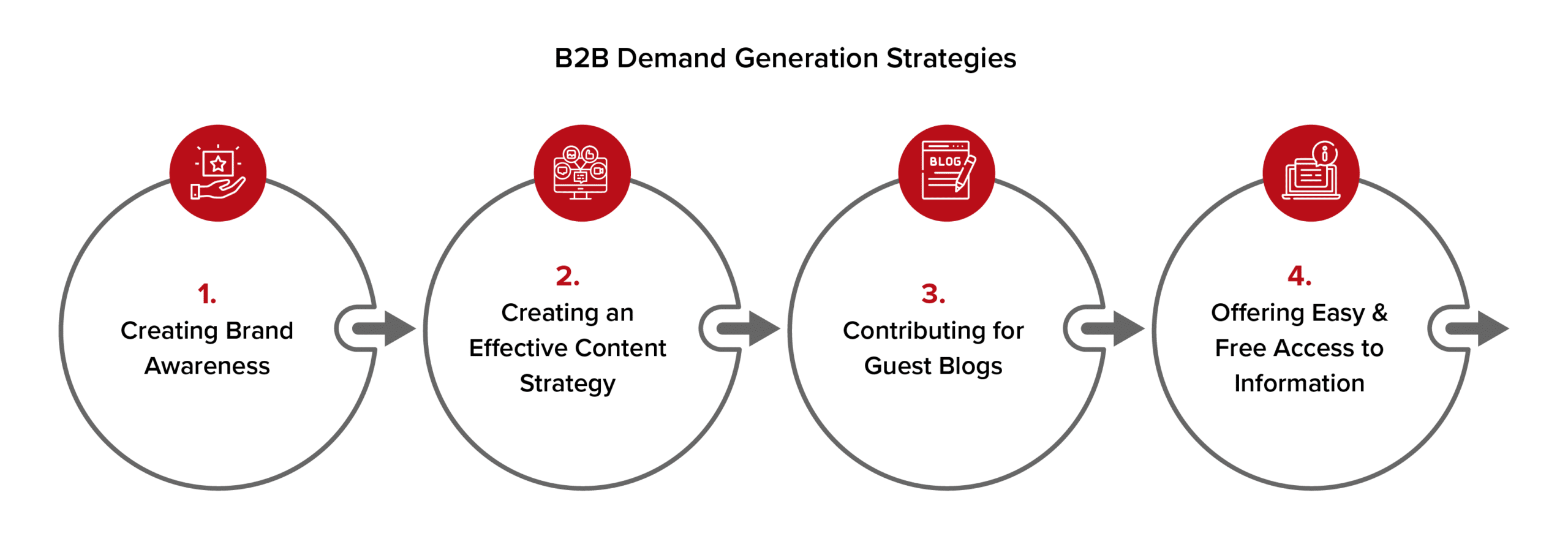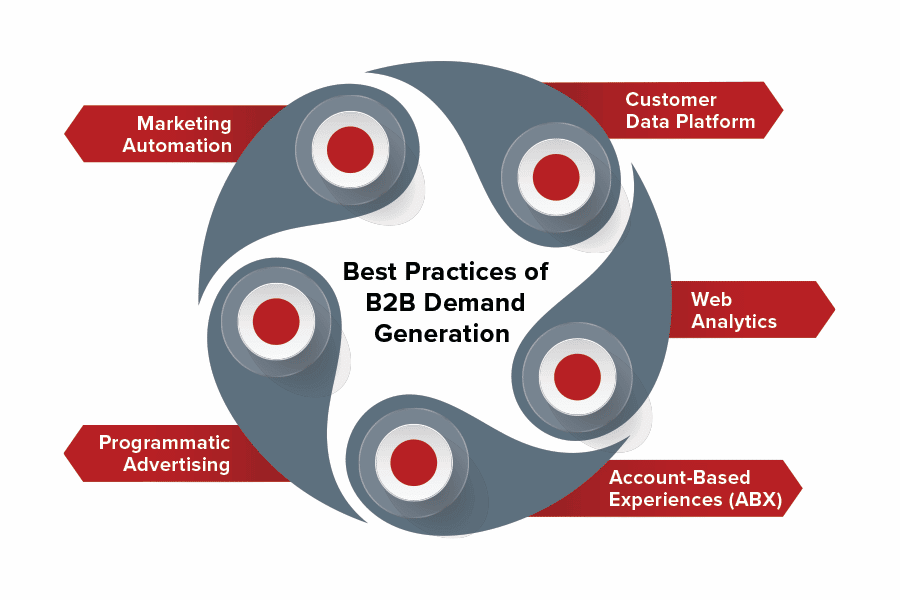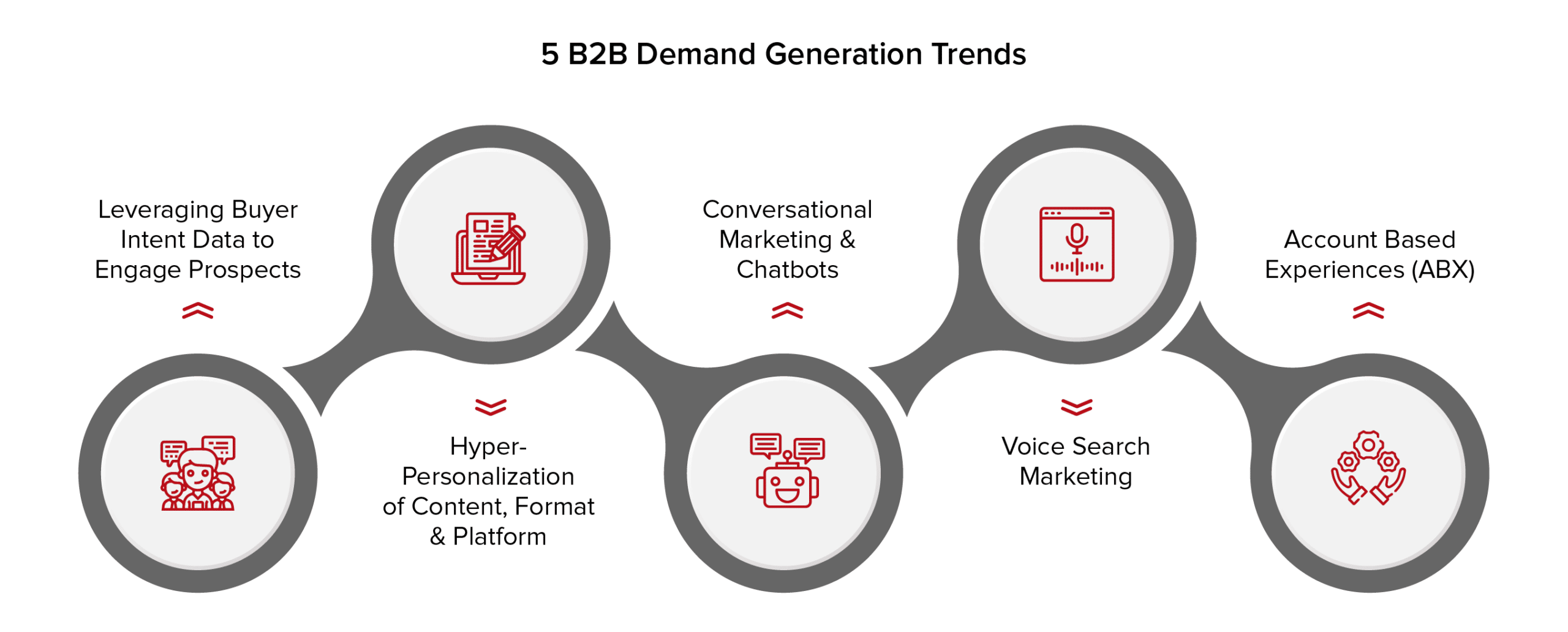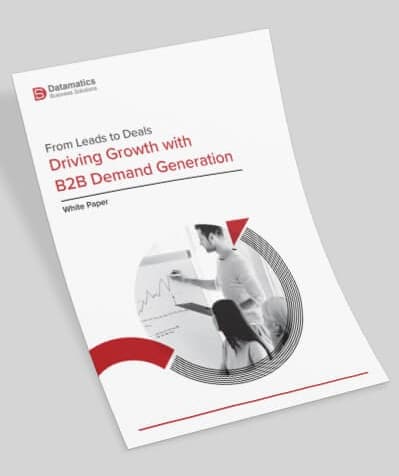Every new year brings a lot of promises and hope for a better future. For the business world, it also brings a new set of challenges. Based on the business performance, market demands and customer buying behavior throughout the year, it can become slightly easy to predict what the year ahead would look like. As demand generation remains one of the most crucial business growth strategies, it would be foolhardy to stick to the same old tactics. As the customer expectations evolve, your business strategies should too.
Through this blog, we will walk through the demand generation strategies and some notable B2B demand generation trends for the year 2023.
Table of Contents
What is B2B Demand Generation?
Demand generation is the process of educating people who resemble your target audience about your products and service offerings. It focuses on creating brand awareness and informing people about your presence. B2B demand generation is primarily about creating demand for your offerings. Marketers focus on widening their audiences, generating desirable buzz about their business and increasing the online traffic – website as well as social media platforms.
The non-negotiable aspect of demand generation is identifying and understanding of customer needs, expectations and challenges of your audience. These insights help you plan your strategies accordingly and establish meaning connections through your marketing campaigns.
People often confuse demand generation with lead generation. Although they are often used interchangeably, there is a big difference between B2B demand generation and B2B lead generation.
Effective B2B Demand Generation Strategies
Demand generation strategies hold a significant role in the world of business. Imagine having a fantastic product or service, but if no one knows about it, what’s the point?
Demand generation is essentially shining a spotlight on what you offer. It involves techniques and tactics that create interest, pique curiosity, and prompt potential customers to take notice. Without these strategies, you’re essentially leaving your success up to chance.
These strategies act as a blueprint, guiding potential customers to your doorstep. Instead of waiting around, you’re taking a proactive approach. This could mean using compelling social media content, eye-catching advertisements, persuasive content, or events that showcase your offerings.
It helps you build a pool of potential customers who not only make purchases but might also become advocates for your brand. Demand generation strategies focus on building relationships with potential customers. By doing so, you’re establishing trust, demonstrating value, and setting the stage for long-term engagement. In essence, a demand generation framework isn’t just about making sales. It’s about crafting a narrative, generating enthusiasm, and establishing connections that can lead to sustained success.
Here are a few strategies you can use to stand out in a crowded market:
1. Creating Brand Awareness
The importance of standing out from the crowd increases when customers have plenty of options to choose from. Your demand generation strategies can well be the differentiating factor. To garner the attention of your potential buyers, brand awareness becomes critical. An effective brand awareness strategy will help you build trust and create long-lasting communication channels with your customers. As the B2B demand generation trends indicate, customer engagement will play a huge role in improving conversions.
2. Creating an Effective Content Strategy
The content you produce has a direct impact on your authority amongst the audience. If they find your content relevant, reliable, accurate and helpful, they are more likely to trust your services and become your customers. Increasing website traffic and strengthening social media presence are an integral part of the content strategy. You must optimize your content to suit the buyer search intent and on-page SEO hygiene.
3. Contributing for Guest Blogs
Off-page SEO can be leveraged to improve SERP ranks and boost your demand generation. You must actively contribute as a guest writer and collaborate with high-authority (DA/PA) websites that attract an audience similar to your buyer persona. Guest posting is one of the most effective and simply ways of expanding your audience reach and educating people about your business offerings.
4. Offering Easy & Free Access to Information
Prospects are keen to consume content and understand every aspect of your product and service. Free content resources work best when people are eager to know more about your business. The more information they have, the more informed decision they can make. Ensure that you provide high-quality content to address their requirements. Before contacting your sales team, they might want to conduct research of their own. This is where your free content resources can be your advocates and pursue them to become your customers.
B2B Demand Generation Best Practices & Strategies
Demand generation best practices are vital for businesses as they establish a structured approach to capturing attention, engaging potential customers, and driving revenue. By building strong brand awareness, generating leads, nurturing relationships, and staying ahead of competitors, these practices create a comprehensive marketing strategy.
They enable companies to adapt to changing market dynamics, leverage data for informed decisions, and foster lasting customer loyalty. Ultimately, demand generation practices serve as a roadmap for sustained growth, ensuring that businesses remain relevant, competitive, and successful in today’s dynamic business landscape.
1. Marketing Automation
Automation has been around ever since the start of the technology era. In marketing, however, it is comparatively new. Even the most seasoned marketers sometimes need help with marketing automation software and tools available at their disposal. However, if used properly, these tools can make their lives a lot easier and help businesses automate repetitive tasks that can quickly be done through marketing automation software.
Nurturing leads throughout the sales funnel is one such task. Whether you are a tech-savvy marketeer, using simple tools like email marketing, lead scoring, and lead nurturing, you can easily target the right prospect with the right messaging. From social media to audience segmentation to effective lead management tools like HubSpot, Salesforce Etc. have taken marketing automation to newer heights while making lives more straightforward and more effective for marketers.
2. Customer Data Platform
Often referred to as CDP, a customer data platform is a system designed for marketers to collect customer data from all sources, develop unique customer profiles, and analyze it. This allows organizations to build a unified customer database using other marketing technology systems. A Customer Data Platform (CDP) allows the marketer to create personalized demand generation campaigns. Some of the particular ways marketers can use CDP include:
- Customer Segmentation: You can leverage your customer data to segment audiences and build tailored marketing campaigns.
- Personalized Messaging: CDP allows you to use customer data to create personalized offers and messaging more likely to resonate with targeted customers.
- Attribution: Using customer data for tracking the effectiveness of various marketing campaigns and channels.
- Data Analysis: Use customer data to analyze customer preferences and behavior, which you can leverage for future marketing strategies.
- Automation: Use customer data for triggering marketing automation for some of the marketing tasks, such as email campaigns or personalized website messages.
3. Programmatic Advertising
Programmatic advertising is one of the most effective ways to reach new audiences. Irrespective of the nature of your business, platforms such as AppNexus, and Google Ads can help you get new audiences with targeted ads for creating brand awareness and even conversions.
Programmatic advertising platforms leverage advanced data analytics algorithms to identify people who have shown interest in your product or services in a particular way, either through your website or app. These platforms also automate the process of buying ad space, which minimizes manual negotiation and allows the marketers to create more effective ad campaigns.
4. Web Analytics
With the amount of customer data generated across platforms regularly, it is only fair for marketers to use that data for their gain. The web analytics platforms such as Google Analytics, Adobe Analytics, and Omniture allow marketers to track website traffic, conversion rates, and user behavior and use all that data to optimize their demand-generation efforts.
You can also use this data to identify trends and patterns in your customer behavior and use that information to make an informed decision about driving more traffic to your website or app. Web analytics tools also help marketers segment audiences by analyzing user behavior, such as new visitors, returning visitors, and high-value customers. This data further allows marketers to create marketing campaigns, which are more likely to generate demand from the identified user segments.
5. Account-Based Experiences (ABX)
Account-Based Experience (ABX) plays a crucial role in modern demand generation strategies. It requires you to create personalized customer experience for targeted high-value accounts. ABX employs a mix of data-driven insights and real-time personalization for creating highly customized and personalized experiences for each of the high-value accounts. This allows you to boost the engagement with the target accounts and drive meaningful conversions, as modern customers are more likely to engage with messages and content that addresses their needs and pain points directly.
Account-Based Experiences also help the sales and marketing teams by providing them with a detailed understanding of target accounts and the strategies that can improve the engagement with them. Overall, ABX is an advanced tool for demand generation, enabling organizations to build stronger relationships with their most valuable accounts and drive growth.
Top 5 B2B Demand Generation Trends for 2023
Ideally, generating demand for your business should be driven by strategy and data. With the emergence of a few notable B2B demand generation trends for 2023, marketers must be on top of their game to ace those trends and stay ahead of their competition. Here are the top 5 B2B demand generation trends for 2023 that marketers must get an in-depth look at –
1. Leveraging Buyer Intent Data to Engage Prospects
Understanding buyer intent is one of the fastest growing B2B demand generation trends. It will take precedence over other demand generation strategies. Marketers will put in more effort into identifying what exactly their target audiences are looking for. In addition to the third-party data, they will depend more on zero and first-party data. The role of technologies like AI and ML will grow multifold as they can offer valuable intent signals from search engines and social channels.
This buyer intent data will prove to be a great asset to understand where exactly the prospect stands in the product discovery and buying journey. Further, you can proactively contact your potential customers and establish a meaningful engagement before your competitor does.
2. Hyper-Personalization of Content, Format & Platform
The importance of personalization in B2B demand generation cannot be emphasized enough.
Customers expect personalized communication and services. In fact, 52% of customers switch to competitors owing to the lack of personalization. This number will only grow higher in the near future.
Customers will engage more with service providers who cater to their needs and preferences. Personalization will no longer be limited to simply sharing content with prospects. Marketers will understand the preferred content formats and the most used device by the customer for consuming content. This will help them optimize their content to reach customers on their preferred platforms, at their preferred time.
3. Omnichannel Presence
Omnichannel strategies are all about giving your customers a consistent and seamless experience across various digital touchpoints. For example, when a customer discovers a product through a social media ad, they then visit the brand’s website to learn more. They might even sign up for their newsletter and start receiving tailored updates via email. What’s key here is that as you transition between these channels—social media, website, email, or the app—the experience should be connected. Customers today want this kind of smooth interaction; they want a unified journey, not a disjointed one. By making sure your online touchpoints offer this cohesion, you’re catering to those expectations and making your customers’ interactions with your brand much more enjoyable and memorable.
4. Content Marketing
Content marketing remains a vital component of demand generation. It caters to various stages of the buyer’s journey, which typically includes the awareness, consideration, and decision stages. At each stage, the content addresses the specific needs, questions, and concerns of the audience. For instance, in the awareness stage, content might focus on addressing pain points and providing educational information. In the consideration stage, it could compare solutions and provide in-depth insights, while the decision stage might involve case studies and product-specific content.
5. Account Based Experiences (ABX)
Talking about B2B demand generation trends, ABX promises to change how marketers approach account-based marketing. Account-based marketing strategies have been a proven demand generation strategy for a long time. However, marketers will need to take it one step ahead and adopt Account-based Experience. They can gather, store and analyze customer data and draw valuable insights into the high-value accounts. Further, they can leverage those insights to create a personalized end-to-end marketing strategy specific to those accounts. This paves the path for ABX – Account-based Experience.
Stay Ahead of Demand Generation Trends
Future of Demand Generation: 5 Emerging Trends
1. Voice Search Marketing
Voice search is slowly revolutionizing the way people search for products and services. It will become a huge part of every B2B demand generation strategy in the near future. It not only offers great convenience to users to simply speak instead of typing into the keypads to find answers. There are already about 133 billion smart speaker users globally. This number will only keep increasing. For marketers, it will be more important to optimize their website content for speech search to avoid missing out on audience groups that prefer voice search as the preferred medium.
2. Influencer Collaborations
With the booming digital era, influencer collaborations have emerged as a powerful strategy that bridges the gap between brands and their target audience. Think of it as a dynamic duo – brands teaming up with individuals who hold sway over a loyal following in specific niches. These influencers have earned their stripes, having established authenticity and credibility with their engaged community. Brands get to tap into the influencer’s trust reservoir, gaining access to a pre-qualified audience that hangs on their every word. From product shout-outs to behind-the-scenes stories, the collaboration possibilities are as varied as the influencer’s content. But like any great partnership, there are nuances to navigate – finding the right influencer, aligning values, and crafting an authentic message that resonates.
3. Virtual Events & Webinars
The surge in virtual events and webinars, accelerated by the pandemic, is and will continue to be a relevant and impactful strategy for businesses. These digital experiences transcend geographical barriers, allowing companies to connect with a global audience without the constraints of physical travel. They offer cost efficiency, accessibility, and flexibility for participants. Beyond their convenience, virtual events provide platforms for showcasing thought leadership, generating leads, and nurturing engagement.
Interactive features foster real-time interactions, while the ability to repurpose content and gather data enhances post-event value. As the world embraces hybrid models, these virtual experiences remain a dynamic and integral component of demand generation efforts, catering to diverse audience needs and expanding a brand’s reach.
4. Marketing Automation
Marketing automation is a B2B marketer’s trustworthy sidekick, handling repetitive marketing tasks effectively. It ensures your messages reach your audience at the right moments. This tool also simplifies social media scheduling, maintaining your online presence effortlessly.
It provides valuable insights into the effectiveness of your strategies, assisting you in making informed decisions. It acts as a strategic collaborator, skillfully nudging potential customers towards making purchases and commemorating the loyalty of existing ones. But hey, amidst all the high-fives for automation, don’t forget that good old human touch is still the secret ingredient for building those real-deal connections!
5. Conversational Marketing & Chatbots
One of the booming B2B demand generation trends is conversational marketing. With customers having plenty of options to choose from, they tend to move on if their queries are not addressed instantly. To address this need for instant gratification of customers, businesses will leverage conversational marketing and chatbots. They will engage with customers through a conversation in real-time. The AI chatbots will not only understand user behavior, intention and communication patterns but also adapt to their pattern and respond accordingly. Moreover, chatbots ensure that your users get their queries resolved in real-time.
Conclusion
After covering the top 5 B2B demand generation trends for 2023, it’s quite clear that demand generation will become more data-driven and customer-centric. The use of technology will grow exponentially. Organizations will have to change their traditional business strategies and make technology an integral part and focus on enhancing customer experience.
Building an in-house team for demand generation might not always be possible for all the organizations. Skill gaps, talent shortage, extra cost – the challenges can be plenty. However, partnering with a demand generation service provider can prove to be a masterstroke in your business growth. These providers not only offer expertise and a tech-driven approach to growth but also are always on top of the future demand generation trends as well.
Get in touch with our experts at [email protected] to discuss how our demand generation services can help you boost your business growth.
Frequently Asked Questions
The 4 Stages of Demand Generation
- Raising awareness about the product.
- Boosting interest in customers’ minds.
- Establishing a market position for your product.
- Persuading the customer to give the product a positive review.
Account-based marketing focuses on communicating with customers one at a time (or in smaller groups) via social media or email marketing, whereas demand generation is more concerned with generating qualified leads and acquiring new clients. ABM can serve a demand generation function in some cases.
